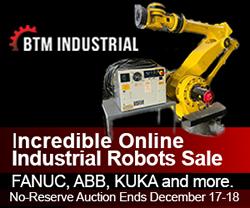Five Open Source AutoPilot UAV Projects
Watch these robotic 'reindeer' from Boston Dynamics pull Santa's sleigh
CES 2016 - Autonomous Cars Set To Dominate
Time-of-Flight Camera - An Introduction
Startup Gets $11M Funding for GPS-enabled Robots
Google Attracts Top U.S. Automakers With Self-Driving Technology
2016 Will Be A Pivotal Year For Social Robots
Three Heavily Funded Robotic Arms Projects on Kickstarter
Google to incubate its robotics and drone divisions under Google X
Drone Light Painting - The Christmas Edit
Automating the Chemo Compounding Process
RoboUniverse San Diego 2015
Four Market Forces That Will Shape Robotics Over The Next Year
HRI Case Study of Wireless Control: 5D Robotics
Getting Started with Collaborative Robots - Part 3 - Get the team on board with robots
Records 2776 to 2790 of 3729
First | Previous | Next | Last
Featured Product

BTM Industrial -The industry leader in assisting companies with surplus assets.
Robotics and Automation - Featured Company

